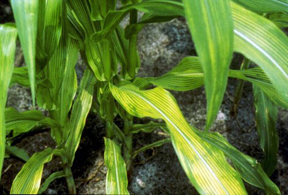Magnesium deficiency issues in Michigan corn fields
Is your field corn looking a little striped? Low magnesium may be your problem.
Recent reports have visually identified magnesium deficiency symptoms in some corn fields throughout Michigan. Interveinal chlorisis, or yellow to white coloring between the veins of older leaves, is an indication of magnesium deficiency. Severe deficiency symptoms can lead to reddish-purpling of older leaves, necrosis of leaf tips and edges, and stunted plant growth. As noted earlier in my May article, Are you sure that yellowing means nitrogen deficiency?, yellowing of plant leaves can be a deficiency indicator for many different nutrients including nitrogen, potassium, sulfur, zinc and iron. Always make sure to review and rule out other nutrient deficiencies by reviewing the resources at the end of this article.
Early season magnesium deficiency symptoms, like early season phosphorus deficiencies, tend to be more prevalent in years with cold, wet soils and on sandier textured soils. As temperatures increase and soils start to dry out, corn and other crops showing deficiency symptoms tend to grow out of the problem. However, should this problem persist, a foliar application of magnesium may be required. A foliar application between 10 and 20 pounds of magnesium sulfate (Epsom salts) in 30 gallons of water is suggested to correct this deficiency.
For more information on deficiency and injury symptoms, refer to Secondary and Micronutrients for Vegetable and Field Crops from Michigan State University Extension or Nutrient Deficiencies and Application Injuries in Field Crops from Iowa State University Extension.

Magnesium deficiency in corn. Photo credit: Rob Mikkelsen, International Plant Nutrition Institute.



 Print
Print Email
Email


